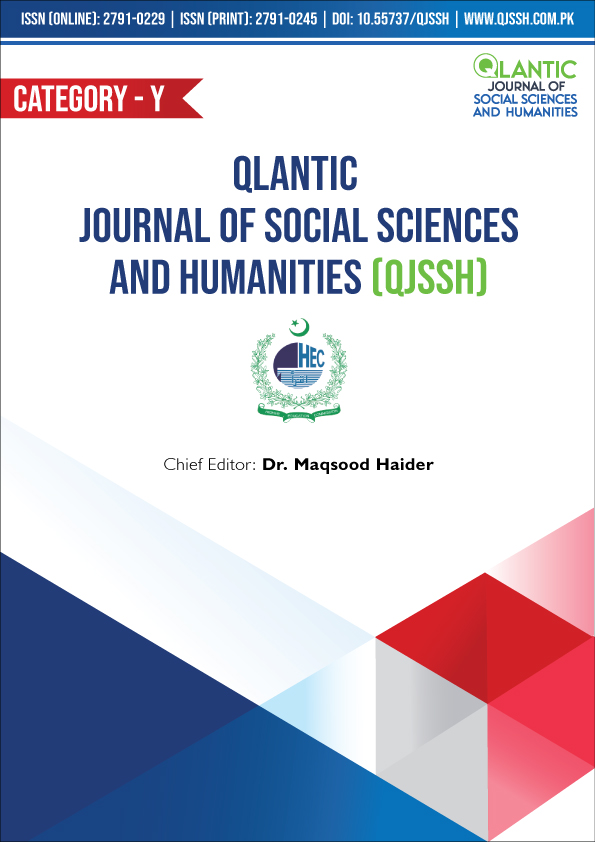Stylistic Strategies of M.R Kayani’s Speech, “Misfortunes Come Not Alone”
DOI:
https://doi.org/10.55737/qjssh.vi-i.25308Keywords:
Kayani’s Speech, “Misfortunes Come Not Alone” Style, Discourse, Narratives, Stylistic StrategiesAbstract
Malak Rustam Kayani (M. R. Kayani) has adopted a unique style in his speeches, addresses, and columns, as mentioned in his texts. Stylistics is the application of linguistic techniques and an objective method of interpretation to explore the style of an author. Through stylistics, critics analyze a literary piece and derive meaning from it. An intellectual titan in the fields of linguistics and cognitive science, Paul Simpson played a vital role in analyzing the style of an author. Style tells us about the manner of expression and how ideas and philosophy are depicted through this manner of expression. Besides manner of expression, choice of words, usage of literary devices, rhythm, the elements of composition, the structure and length of a sentence are also considered integral parts of style. This study is about the stylistic strategy of Kayani's speech, "Misfortunes Come Not Alone" for which Paul Simpson's Stylistics is used as a theoretical framework. The speech is replete with subtle attacks on dictatorship, despotism, and raising voices for civil supremacy. His usage of metaphor, simile, and irony can be put under the barometer of the tools of stylistics in this research paper.
References
Abraitienė, L., Koverienė, I., & Urbonienė, J. (2015). Challenges and Rewards of Surtitling as an Audiovisual Translation Mode: A Case Study of the Contemporary Opera Have a Good Day! Studies About Languages, 0(26). https://doi.org/10.5755/j01.sal.0.26.12422
Al- Erjan, R. Sh. (2022). A Stylistic Analysis of John Keats’s Poem “Ode to Psyche.” Theory and Practice in Language Studies, 12(7), 1378–1385. https://doi.org/10.17507/tpls.1207.18
Dynel, M. (2013). Humorous phenomena in dramatic discourse. European Journal of Humour Research, 1(1), 22–60. https://doi.org/10.7592/EJHR2013.1.1.dynel
Hariyana, A., Rasyid, Y., M. P., Anwar, M., & MPhil, M. H. (2020). The Representation of Women in Pendhoza’s Bojoku Galak’s Song through Sara Mills’s Critical Discourse Analysis Model. KnE Social Sciences. https://doi.org/10.18502/kss.v4i14.7914
Hashem, Z A., & Muhi, T H. (2021, April 19). Semantic deviation in Arabic and English proverbs of love. https://scite.ai/reports/10.21744/ijllc.v7n3.1486
Kayani, J. M. R., (2006). The Whole Truth. Misfortunes Come Not Alone. Pakistan Writers Co-operative Society, Lahore, p.13 https://www.cooperaartgallery.com/product/the-whole-truth/
Kayani, J. M. R., (2006). The Whole Truth. Misfortunes Come Not Alone. Pakistan Writers Co-operative Society, Lahore, pp.16-17 https://www.cooperaartgallery.com/product/the-whole-truth/
Kayani, J. M. R., (2006). The Whole Truth. Misfortunes Come Not Alone. Pakistan Writers Co-operative Society, Lahore, p.17 https://www.cooperaartgallery.com/product/the-whole-truth/
Kayani, J. M. R., (2006). The Whole Truth. Misfortunes Come Not Alone. Pakistan Writers Co-operative Society, Lahore, p.17 https://www.cooperaartgallery.com/product/the-whole-truth/
Kayani, J. M. R., (2006). The Whole Truth. Misfortunes Come Not Alone. Pakistan Writers Co-operative Society, Lahore, p.18 https://www.cooperaartgallery.com/product/the-whole-truth/
Kayani, J. M. R., (2006). The Whole Truth. Misfortunes Come Not Alone, Pakistan Writers Co-operative Society, Lahore, p. 118 https://www.cooperaartgallery.com/product/the-whole-truth/
Kayani, J. M. R., (2006). The Whole Truth. Misfortunes Come Not Alone, Pakistan Writers Co-operative Society, Lahore, p. 119 https://www.cooperaartgallery.com/product/the-whole-truth/
Kayani, J. M. R., (2006). The Whole Truth. Misfortunes Come Not Alone. Pakistan Writers Co-operative Society, Lahore, p.20 https://www.cooperaartgallery.com/product/the-whole-truth/
Kayani, J. M. R., (2006). The Whole Truth. Misfortunes Come Not Alone. Pakistan Writers Co-operative Society, Lahore, p.20 https://www.cooperaartgallery.com/product/the-whole-truth/
Kayani, J. M. R., (2006). The Whole Truth. Misfortunes Come Not Alone. Pakistan Writers Co-operative Society, Lahore, p.21 https://www.cooperaartgallery.com/product/the-whole-truth/
Kayani, J. M. R., (2006). The Whole Truth. Misfortunes Come Not Alone, Pakistan Writers Co-operative Society, Lahore, p. 122 https://www.cooperaartgallery.com/product/the-whole-truth/
Kayani, J. M. R., (2006). The Whole Truth. Misfortunes Come Not Alone. Pakistan Writers Co-operative Society, Lahore, p.23 https://www.cooperaartgallery.com/product/the-whole-truth/
Kayani, J. M. R., (2006). The Whole Truth. Misfortunes Come Not Alone. Pakistan Writers Co-operative Society, Lahore, p.23 https://www.cooperaartgallery.com/product/the-whole-truth/
Kayani, J. M. R., (2006). The Whole Truth. Misfortunes Come Not Alone, Pakistan Writers Co-operative Society, Lahore, p. 125 https://www.cooperaartgallery.com/product/the-whole-truth/
Kayani, J. M. R., (2006). The Whole Truth. Misfortunes Come Not Alone, Pakistan Writers Co-operative Society, Lahore, p. 128 https://www.cooperaartgallery.com/product/the-whole-truth/
Kayani, J. M. R., (2006). The Whole Truth. Misfortunes Come Not Alone, Pakistan Writers Co-operative Society, Lahore, p. 129 https://www.cooperaartgallery.com/product/the-whole-truth/
Kayani, J. M. R., (2006). The Whole Truth. Misfortunes Come Not Alone, Pakistan Writers Co-operative Society, Lahore, p. 17 https://www.cooperaartgallery.com/product/the-whole-truth/
Khan, I. A. (2006). The Whole Truth. Stunning Vindication of Truth, part 1 Pakistan Writers Co-operative Society, Lahore, p.4 https://www.goodreads.com/book/show/40815849-the-whole-truth
Khan, I. A. (2006). The Whole Truth. Stunning Vindication of Truth, part 1 Pakistan Writers Co-operative Society, Lahore, p.3. https://www.goodreads.com/book/show/40815849-the-whole-truth
Muhammadiah, M., Tannuary, A., Romadhianti, R., Fatmawati, E., & Herman, H. (2023). Critical Discourse Analysis in the Education Community to Respond the Hoax Based on Technology and Information. AL-ISHLAH: Jurnal Pendidikan, 15(1), 95–104. https://doi.org/10.35445/alishlah.v15i1.2158
Nyklová, B., & Fárová, N. (2018). Scenes in and outside the library: Continuity and change in contesting feminist knowledge on the semi-periphery. Sociologija, 60(1), 194–209. https://doi.org/10.2298/SOC1801194N
Özçelik, K. (2022, November 24). The Sense of an Ending: A Postmodern Challenge of Truth. https://scite.ai/reports/10.5430/wjel.v13n1p62
Petrou, N., Christodoulou, C., Anastasiou, A., Pallis, G., &Dikaiakos, M. D. (2023). A Multiple change-point detection framework on linguistic characteristics of real versus fake news articles. Scientific Reports, 13(1), 6086. https://doi.org/10.1038/s41598-023-32952-3
Sorlin, S. (2016). From a Stylistic Angle: Methodological Issues and Liminal Creativity. Angles, 3. https://doi.org/10.4000/angles.1625
Stria, I. (2018). Linguistic worldview in multilingual groups as an indicator of developing a communal identity: The case of Esperanto. Etnolingwistyka. Problemy Języka i Kultury, 30, 215. https://doi.org/10.17951/et.2018.30.215
Wulandari, S., &Triandana, A. (2022). Social protest style in the novel Perempuan yang Menangiskepada Bulan Hitam by Dian Purnomo: stylistic studies. BAHASTRA, 42(2), 119–131. https://doi.org/10.26555/bs.v42i2.232
Zainuddin, Z. (2016). The Impact of Personality: Extrovert vs. Introvert on the Ability in Syntax in Essay Writing. Studies in English Language and Education, 3(2), 158–169. https://doi.org/10.24815/siele.v3i2.4963
Downloads
Published
Issue
Section
License
Copyright (c) 2025 Fateh Khan, Dr. Zahir Jang Khattak, Dr. Gulzar Ahmad

This work is licensed under a Creative Commons Attribution-NonCommercial 4.0 International License.





